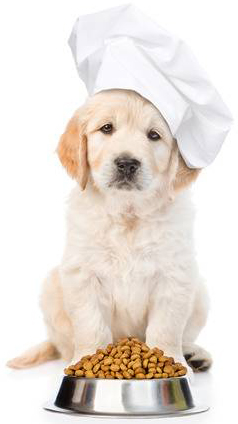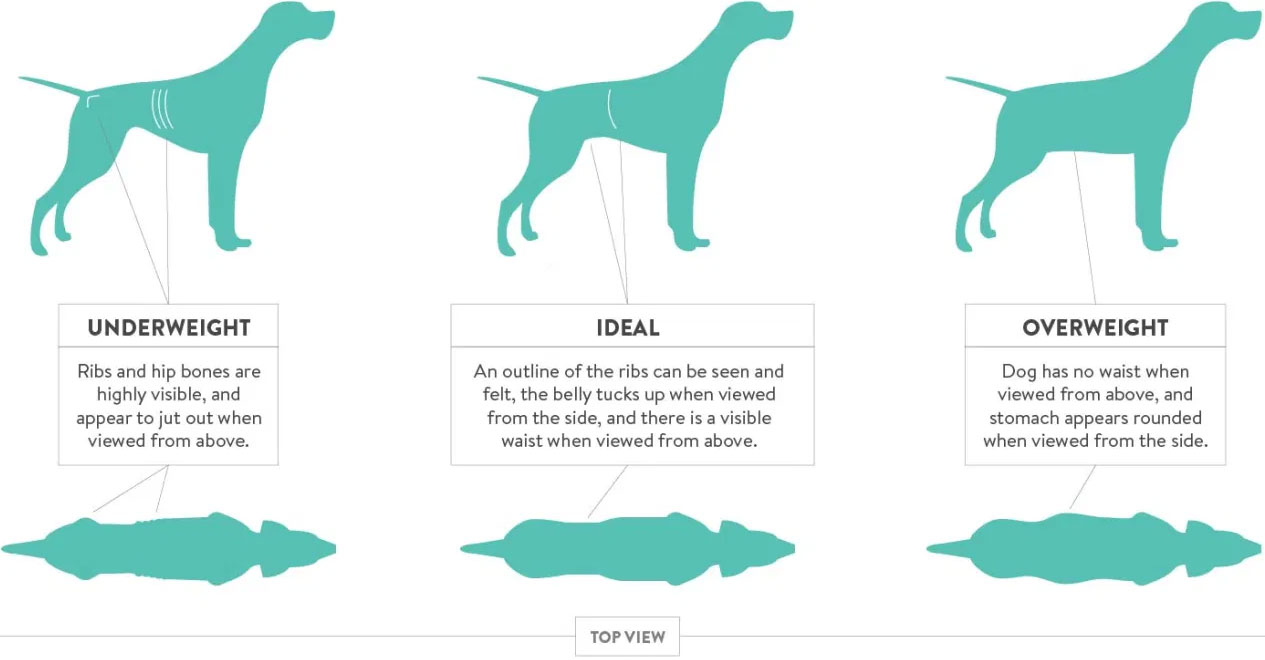Dog Food. Your Pup Needs You To Read This
 As dog pawrents we understand the desire to give our pups the best possible dog food but the amount of information out there can be very overwhelming, especially for newbies in nutrition or dogs in general.
As dog pawrents we understand the desire to give our pups the best possible dog food but the amount of information out there can be very overwhelming, especially for newbies in nutrition or dogs in general.
Our students always ask us questions related to this topic and seem concerned about lacking the knowledge to understand how to judge dog foods by themselves, so they end up just feeding what’s popular out there, completely blind to the actual quality of such kibble.
This is why we came up with this simple guide for everyone to start their journey into the world of canine nutrition in a very easy way.
After reading this you’ll be able to easily judge dog foods by yourself and will be surprised about what you and your friends have been buying.
How can I easily tell if a brand is good or not beyond other people’s opinions?
Why not just go with what vets recommend?
We’ve even mentioned this concern to some dog nutritionists and they agreed with us. One speculation is vets just say that because they’re popular easy to find brands but veterinarians don’t study nutrition (or behavior) in depth so their forte is neither nutrition nor behavior but physical health in medical terms. You’ll disagree with those recommendations too when you finish reading this guide and learn to understand at least the ingredient list of any brand to judge for yourself.
Please, always seek specific advise from a professional of the specific area of study you’re struggling with in order to get the most accurate information and keep your pup safe and healthy in every aspect. No professional covers every aspect of animals or humans.
What’s up with the grain-free / grain-inclusive debate?
This mess started after the FDA received a significant amount of reports of dogs with DCM (a condition that prevents the heart from pumping blood properly). They haven’t been able to conclude any definite connection between the disease and their diets but it’s a possibility.
Amongst the posible theories currently being studied if that one of the causes for DCM is taurine deficiency, but there’s other potential causes as well that may involve several aspects of food recipes.
One fact that may explain why grain-free diets could be seen as the root of problems before having proof is that, in the last few years, they became highly popular and most dogs in general went on grain-free diets. This automatically raises the probability of dogs in the reports to be on grain-free diets without it necessarily meaning the food caused DCM.
Also, the reports received by the FDA include dogs on grain-inclusive diets as well as vegetarian and vegan formulations in all forms (kibble, canned, raw and home-cooked).
These facts make it hard to simply blame specific brands, recipes or ingredients and that’s why the investigation on dog food is still ongoing.
So, should I feed grain-free or grain-inclusive?
The best solution in our hands is to apply a life rule: balance and moderation. This means we feed a grain-free bag and then a grain-inclusive bag always making sure they’re both high quality, of course. Changing brands also lowers the risk of them getting sick or so because if a specific brand has harmful ingredients and we don’t know it, they’ll require long term exposure (years, usually) to actually harm our pups. By avoiding following patterns, we decrease the risk if new discoveries are made in the future.
I heard peas, lentils and potatoes are bad for dogs
Examples of legumes are peas, chickpeas, soybeans and lentils. They’re commonly added to animal and human food as a source of protein. In dog food, their proportion in recipes seems much higher in grain-free diets.
What about grains like rice?
But there’s so many brands! How do I pick just one?
Keep your pup’s needs in mind! One brand may have an outstanding recipe for senior dogs but not so much for puppies. Some others have excellent recipes but they’re all for high energy dogs and so on.
Most of the times we end up with 2-3 options to shop for and the final decision is made by costs depending on our budget. We keep the names of the other top brands for future reference too.
Won’t the constant switching from grain-free to grain-inclusive upset my dog’s tummy?
We recommend that you get the new bag of kibble when the old one is getting close to the end so you mix them increasing the amount of the new kibble progressively. This way your dog’s tummy gets an easy transition. Any stool that’s looser than usual during this process is normal as long as there’s no blood, completely liquid stools and other evidently abnormal circumstances.
What about “unusual” proteins (lamb, venison, kangaroo, etc.)?
I bought a brand of kibble with great ingredients and reviews but my dog is not thriving
As long as there’s no evident signs of illness or allergies (blood, rashes, completely liquid stools, etc), just change recipes until you figure out what works for your pup and what doesn’t, always keeping in mind the importance of high quality ingredients. If you notice significant symptoms like the ones in the parenthesis or others, consult with your vet ASAP.
I have a large dog. Do I need to get a brand specifically for large dogs?
What about supplements?
Our greatest find so far!
One time Key had been limping for a couple days without improving so we were just limiting his activity and giving him some of the left over medication that he got when the initial injury happened but it would only help for a few hours and wouldn’t solve the problem.
We always avoid medication unless strictly necessary so that their bodies don’t develop resistance and make actual emergencies even worse. For this reason, we went online and did some research on natural ways to help him and along came salvation: GINGER!
 We got some fresh ginger root. Peeled and grated some of it and added it to his dinner (about 1-2 teaspoons). You may not believe this but in the morning the limping was 100% gone! It was so odd that we thought maybe the medication from before plus resting did it. That night he got more ginger, just in case. We forgot to add the ginger to his dinner on the third day and by the morning he was limping again. It was suspicious so we gave him ginger again that night and by the next morning… MAGIC! Limping be gone!!! It sounds crazy but that tiny amount of ginger was the only reason why he would “magically” be back to his normal self so quickly.
We got some fresh ginger root. Peeled and grated some of it and added it to his dinner (about 1-2 teaspoons). You may not believe this but in the morning the limping was 100% gone! It was so odd that we thought maybe the medication from before plus resting did it. That night he got more ginger, just in case. We forgot to add the ginger to his dinner on the third day and by the morning he was limping again. It was suspicious so we gave him ginger again that night and by the next morning… MAGIC! Limping be gone!!! It sounds crazy but that tiny amount of ginger was the only reason why he would “magically” be back to his normal self so quickly.
Ginger has anti-inflamatory properties that proved to be on the edge of miraculous for Key and, being an all natural product, there’s no added risks or considerations that medication has. It’s also cheap and easy to add without any cooking or other processes. It also helps with digestion, nausea, arthritis and it’s believed to help with cancer, heartworm and bloat.
Now that Key is a senior doggo more prone to joint issues, we try to add some ginger to his meal every now and then and always mention this story to as many dog pawrents as possible in case their pups ever need it.
WARNING: ginger may thin the blood so you must mention this and any other supplement to your vet if you’re planning a surgery or if your dog has any special medical conditions like diabetes.
How much food should I be serving & how often?
As for the amount of food, if you have a new dog, we suggest you use the guide on the back of the bag to start with and check your pup’s waist area after a week. Just like people, every dog is different, so there’s no set rule on how much dogs in general should eat.
All dogs, regardless of breed, must always have a visible waist line when looked from above (or just feel it by sliding your hands along the sides). The rules are simple:
1. If you see/feel the ribs too much or the hip bones at the base of the tail are popping up, you should increase the portions (dogs like whippets, afghan hounds and similar running breeds are exceptions because they’re supposed to look like this and it doesn’t mean they’re skinny).
2. If you see/feel a straight line or even thicker from ribs to tail (no waist), your pup is overweight and you must reduce the portions.
Dogs gain and loose weight very quickly and their needs change through time, so don’t worry if you notice your dog got skinny/fat because by adjusting the portions, they’ll be fine in a week or two. Also, it’s normal for puppies around 6 months to look emaciated even if they’re eating properly. They’re just growing up too quickly and it’s hard to keep up. Just keep following the rules from above and they’ll be just fine.
Please, be responsible. Animal obesity is animal cruelty as it reduces their quality of life, makes them prone to sickness and even reduces their life span.




